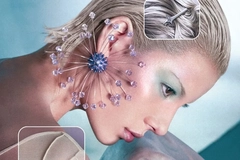French authority uncovers labeling and substance anomalies reserved for professional cosmetics

03 Jul 2023 --- The Directorate General for Competition, Consumer Affairs and Fraud Prevention of the Government of France (DGCCRF) has detected a 31% rate of anomalies in personal care products reserved for professional hair, nail or eyebrow use, as well as in the labeling of allergens, nanomaterials and prohibited substances.
The DGCCRF conducted 255 inspections at 110 online and brick-and-mortar stores in 2022. Many stores were in shopping centers, mainly hairdressing, beauty and manicure salons.
“If the regulations do not provide for express provisions prohibiting the sale of products for professional use to individuals, it is the responsibility of the operators to take all the necessary precautions to prevent the use by the general public of such products,” the DGCCRF states.
The joint laboratory service analyzed sixteen samples and detected a 31% rate of anomalies. Two products, an eyelash and eyebrow tint, had an anomaly specific to substances reserved for professionals. The products contained a prohibited ingredient not mentioned in the conditions for use.
Three other products sampled also showed composition anomalies – a semi-permanent mascara contained an unlabeled substance (benzyl alcohol); a hair product contained a prohibited substance (butylphenyl methylpropional) and a hair straightening product had D4 (octamethylcyclotetrasiloxane), a banned substance.
Labeled for professional use The DGCCRF detected a 31% rate of anomalies in the analyzed product samples.
The DGCCRF detected a 31% rate of anomalies in the analyzed product samples.
The investigation was conducted in light of concerns that consumers buy cosmetics from specialized brands rather than going to a professional salon. Precautions are necessary when using certain cosmetics because they contain restricted substances or have higher concentrations than the authorized limit.
The investigations are carried out to monitor and regulate the accuracy of personal care product labels.
According to the DGCCRF, a product designated for “professional use” should not be confused with a “professional” product that claims to distinguish it from similar products by a more effective formulation while it is not subject to a legal framework.
An example of a non-conformity was found in a hair coloring product based on phenylenediamines and diamino benzenes, which are strictly reserved for professionals but displayed the statement: “Use recommended by a professional in view of the technical expertise required for implementation” instead of the obligatory mention “reserved for professionals.”
The label must be justified, or the qualification could be considered misleading. In the cosmetics space, products for “professional use” must be labeled “reserved for professional use” and special precautions indicated, such as “avoid contact with the skin” or “read the instructions for use carefully.”
Products for “professional use” must comply with the maximum authorized concentrations of substances listed in the regulations.
Making the distinction
Hair coloring products, bleaching, smoothing, permanent wave, straightening, oxidation type; semi-permanent nail polish and eyelash tinting products receive particular attention given the presence of substances only authorized for professional use or subject to restriction.
General products and those classified for “professional use” are often displayed on the same shelves. The products are generally arranged according to their category and expected effects.
According to the DGCCRF, these operating differences will likely induce a distortion of competition or distort the information consumers receive.
The survey revealed that semi-permanent varnishes reserved for professional use are widely marketed to individuals, supermarkets and hypermarkets. In one example, there was no signage to inform consumers about the conditions of use of these varnishes and the absence of any verification of professional quality at checkout. The DGCCRF is doing controls for nanomaterials in cosmetic products.
The DGCCRF is doing controls for nanomaterials in cosmetic products.
During the inspections, several hypermarkets and supermarkets selling semi-permanent varnishes received compliance orders and voluntarily withdrew the products.
Other anomalies noted include the absence of any indication of the special precautions for use, no French translation of the instructions or the lack of a list of ingredients.
Controls on regulated materials
Controls on the “nanomaterials” section and other regulated substances will continue this year in sunscreen products, including those containing chemical filters.
To ensure sufficient consumer protection, products for professional use must be marked and physically separated from products for the general public. Without signage and physical separation of the products, the distributor exposes himself to a sanction for misleading commercial practice or deception.
Furthermore, sellers who check the buyer’s status by asking for proof of activity or a Siret number should be encouraged. Similarly, a “clearance” system can allow consumers to be duly informed of the specifics of the products they wish to purchase.
Last week, the Scientific Committee on Consumer Safety revised the guidance on the safety assessment of nanomaterials in cosmetics for the second time. The committee continues to alter the guidance as science advances.
In 2021, 44 cosmetic products were sampled and analyzed by the common laboratory service of the DGCCRF. The analysis showed that 86% presented anomalies related to the presence of nanomaterials.
The lack of indication on labeling allergens constituted the largest share of non-compliances and mainly affects hair products, leave-in products and skin cleansing products.
Ten percent of products were deemed non-compliant and dangerous because they contained prohibited substances (e.g., D4, hydroquinone, clobetasol propionate), traces of heavy metals or substances present in quantities exceeding regulatory thresholds (e.g., phenoxyethanol, CMIT/MIT, hydrogen peroxide).
In related news, the US Modernization of Cosmetics Regulation Act was passed in December 2022 and now provides the FDA with new authorities. This law is expected to ensure the safety of cosmetic products on the market.
By Inga de Jong












